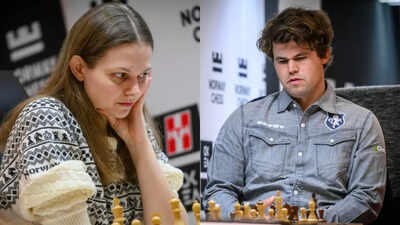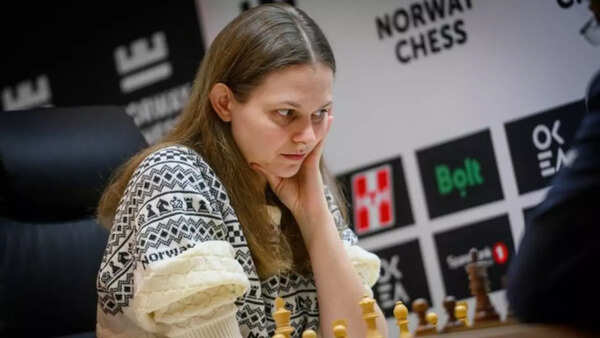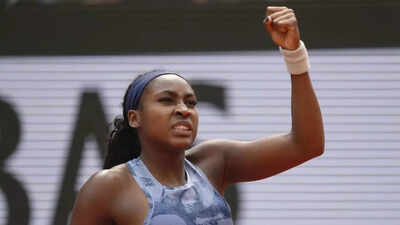Norway Chess: Anna Muzychuk draws less hype, but earns same prize money as Magnus Carlsen after women’s title | Chess News

NEW DELHI: “In sports, you never know what will happen,” GM Anna Muzychuk had said during a chat with TimesofIndia.com last February. Back then, Ukraine’s No. 1 was looking ahead to 2025 with cautious optimism.Five months on, Muzychuk has three back-to-back classical chess titles under her belt: the Nicosia Grand Prix in March, Grosslobming Grand Prix in May, and now the prestigious Norway Chess.Despite her consistent form, the current World No. 6 (based on live ratings) entered the Stavanger event without much fanfare.Go Beyond The Boundary with our YouTube channel. SUBSCRIBE NOW!The spotlight was instead on reigning world champion Ju Wenjun, former champion Lei Tingjie, India’s Koneru Humpy, and rising stars like Vaishali Rameshbabu and Sara Khadem.On social media and in chess circles, most conversations overlooked Muzychuk’s quiet momentum, while global attention was heavily skewed towards big names in the Open section: Magnus Carlsen’s return to classical chess, his on-board rivalry against World Champion D Gukesh, and elite players like Hikaru Nakamura, Arjun Erigaisi, and Fabiano Caruana.Amid this high-profile cast, Muzychuk stayed away from public scrutiny — until her results did the talking.“Yes, last year, I finished second behind the Women’s World Champion… It would be wonderful if I could win it,” Ukraine’s top-rated Grandmaster had said before the tournament.She did, and she did it effortlessly. The 35-year-old was the only player in the women’s field to remain unbeaten in classical games this year.With four classical wins and steady results in the Armageddon rounds, she amassed 16.5 points, enough to edge the rest and secure the title.Along with the trophy, Muzychuk also received NOK 700,000 (approximately Rs 59 lakh), the same amount awarded to Carlsen for winning the Open section.This edition marked the first time Norway Chess offered equal prize money across both sections, a move hailed as a significant step for women’s chess.“For us, as women, we are very excited about it. It’s very important and a big step forward,” Muzychuk had stated earlier. “As you know, in general, there are more open tournaments, which are mainly for men, and the prize funds in those tournaments are usually higher. So we would love to see more women’s events with higher prizes. That would be a great motivation for us and for the next generation, showing them that such tournaments exist and what they can aspire to achieve.“
Prize Money: Open vs Women’s Winners
| Tournament | Open Prize Fund | Women’s Prize Fund | Open Winner Prize | Women’s Winner Prize |
|---|---|---|---|---|
| Norway Chess 2024 | 1.69M NOK | 1.69M NOK | 700,000 NOK | 700,000 NOK |
| FIDE Grand Swiss 2025 | $625,000 | $230,000 | $80,000 (approx) | $25,000 |
| European Individual Championships | €100,000 | €60,000 | €20,000 (approx) | €10,000 |
| FIDE World Cup | $1.89M | $676,250 | $110,000 | $50,000 |
| Asian Chess Championships | $50,000 | $25,000 | $10,000 (approx) | $6,000 (approx) |
| African Chess Championships | $20,000 | $10,000 | $4,000 (approx) | $3,000 (approx) |

Anna Muzychuk (Norway Chess/Michal Walusza)
The Norway Chess format itself is unique.A win in the classical round earns 3 points. A draw leads to an Armageddon tiebreak, where a win grants 1.5 points and a loss, 1 point.ALSO READ: Rs 50,000 a month and countless sacrifices: How India’s chess future shapes up in Chennai hutIn Armageddon, White gets 10 minutes and must win; Black gets 7 minutes (with a 1-second increment after move 41) and wins the game if it ends in a draw.“Usually, in my case in Armageddon, I just play the game, but I always keep in mind that a draw favours Black. So if I have a choice between simplifying or going for something more complex, I might prefer the simpler option,” Muzychuk explained. “If I’m White, I might go for complexity. But if I get a chance to force a draw with a perpetual check, I might take it instead of risking everything.”With this title, Muzychuk has reinforced her status as one of the most consistent performers in women’s chess today, even if the spotlight hasn’t always followed.




